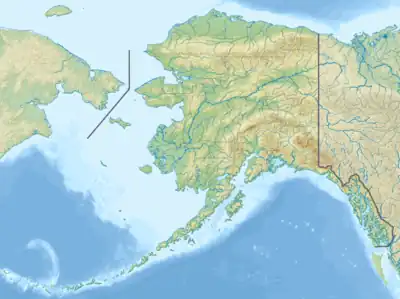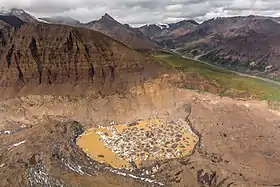| Castle Mountain | |
|---|---|
 Castle Mountain, east aspect | |
| Highest point | |
| Elevation | 8,620 ft (2,630 m)[1] |
| Prominence | 1,170 ft (360 m) |
| Isolation | 4.63 mi (7.45 km) |
| Coordinates | 61°38′55″N 141°59′07″W / 61.6487331°N 141.9853939°W[2] |
| Geography | |
 Castle Mountain Location of Castle Mountain in Alaska | |
| Location | Wrangell-St. Elias National Park Valdez-Cordova Borough Alaska, United States |
| Parent range | Wrangell Mountains |
| Topo map | USGS McCarthy C-3 |
| Geology | |
| Type of rock | Sedimentary rock |
Castle Mountain is a remote 8,620-foot (2,630-meter) mountain summit located at the southeastern edge of the Wrangell Mountains, in the U.S. state of Alaska. The peak is situated 35 mi (56 km) northeast of McCarthy at Skolai Pass in Wrangell-St. Elias National Park and Preserve. Although modest in elevation, relief is significant as the south face rises 4,000 feet above the terminus of the Russell Glacier in less than one mile. Precipitation runoff from the peak drains east via the White River, and west to the Nizina River via Skolai Creek. The mountain's descriptive name was reported in 1914 by the United States Geological Survey.[2]
Climate
Based on the Köppen climate classification, Castle Mountain is located in a subarctic climate zone with long, cold, snowy winters, and cool summers.[3] Weather systems coming off the Gulf of Alaska are forced upwards by the Wrangell Mountains (orographic lift), causing heavy precipitation in the form of rainfall and snowfall. Temperatures can drop below −20 °F with wind chill factors below −30 °F. The months May through June offer the most favorable weather for viewing and climbing.

See also
References
- ↑ Castle Mountain AK, listsofjohn.com
- 1 2 "Castle Mountain". Geographic Names Information System. United States Geological Survey, United States Department of the Interior. Retrieved 2020-02-22.
- ↑ Peel, M. C.; Finlayson, B. L.; McMahon, T. A. (2007). "Updated world map of the Köppen−Geiger climate classification". Hydrol. Earth Syst. Sci. 11. ISSN 1027-5606.
External links
- Weather forecast: Castle Mountain
- Flickr photo: Southwest aspect from Chitistone Pass